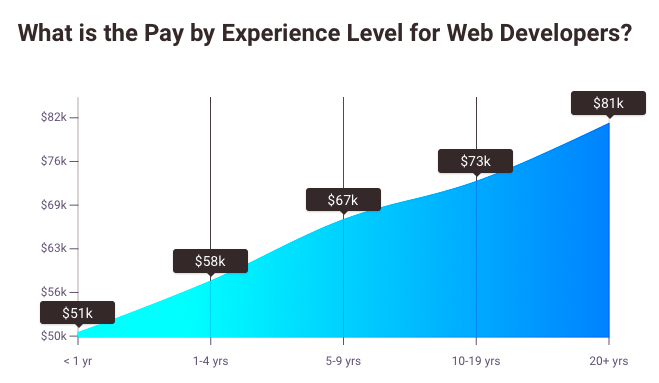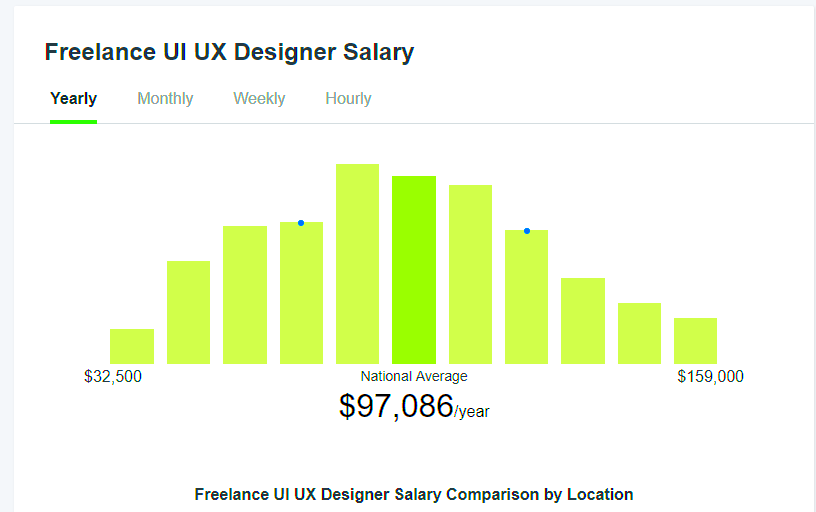Freelance web design is a growing field where designers can set their own rates, choose clients, and work on exciting projects. However, understanding how much freelance web designers typically make can be tricky, as earnings depend on various factors. The good news is, with the right skills, portfolio, and business strategies, web designers can earn a comfortable living. In this post, we will explore the factors that affect earnings, the average salary range, and ways to boost your income as a freelance web designer.
Factors That Influence Freelance Web Design Income

Several factors play a role in determining how much a freelance web designer earns. These include:
- Experience – More experienced designers can charge higher rates for their services.
- Skill Set – Specializing in certain web design tools or frameworks (like WordPress, Shopify, or React) can increase your earning potential.
- Client Base – Working with high-paying clients or in-demand industries can significantly boost income.
- Location – Designers based in countries with a higher cost of living can often charge more than those in areas with a lower cost of living.
- Market Demand – The more businesses require web design services, the more competitive the market becomes, affecting rates.
- Reputation – Building a strong reputation through positive reviews and a solid portfolio will attract higher-paying clients.
By focusing on these factors, freelance web designers can create strategies to increase their income and sustain a successful career.
Also Read This: Best 10 Fiverr Gigs for Jewelry Design in 2024
Average Earnings for Freelance Web Designers

The income of freelance web designers varies widely depending on experience, skill level, and the types of projects they take on. On average, freelance web designers earn:
- Entry-level (0-2 years of experience): Around $25-$40 per hour or $30,000-$50,000 annually.
- Mid-level (2-5 years of experience): $40-$60 per hour or $50,000-$75,000 annually.
- Experienced (5+ years of experience): $60-$100 per hour or $75,000-$150,000+ annually.
Of course, these figures can fluctuate depending on where you live, the type of clients you work with, and whether you work on large projects or smaller gigs. Freelancers who specialize in niche areas (e.g., eCommerce web design or UX/UI design) can command even higher rates.
Keep in mind that project-based pricing is also common in freelance web design. For instance, a full website design project could cost anywhere from $2,000 to $10,000 or more depending on complexity and scope.
Also Read This: Determining Fees for Freelance Logo Design
How Location Affects Freelance Web Design Rates
Your location can have a significant impact on how much you can charge as a freelance web designer. While the digital world allows you to work with clients globally, certain factors tied to where you live can influence your rates. Let’s break it down:
- Cost of Living: In cities with a high cost of living, like New York or London, freelance web designers tend to charge higher rates to cover their expenses. On the other hand, designers in smaller towns or countries with a lower cost of living may have to adjust their pricing accordingly.
- Market Demand: Some locations have a higher demand for web design services than others. For example, tech hubs like Silicon Valley or Berlin often have more clients looking for web designers, which can drive rates up.
- Competition: In crowded markets, like major cities, freelancers may have to lower their rates to stay competitive. However, in less saturated markets, you may be able to charge more for your services due to fewer available professionals.
- Local Regulations: Certain areas have different tax rates, business regulations, and even freelancer protections that can impact how much you charge to ensure you’re covering any additional costs.
Ultimately, while location matters, it’s important to balance market conditions with your personal expertise. By strategically adjusting your rates based on location and demand, you can maximize your freelance income.
Also Read This: How Do You Get Paid from Fiverr?
Understanding Project-Based vs Hourly Rates
When it comes to pricing your web design services, you’ll typically have two options: hourly rates or project-based pricing. Each has its pros and cons, depending on the type of work and the client’s needs. Here’s what you should know:
- Hourly Rates: Charging by the hour means you get paid for the actual time spent on the project. This is ideal for smaller, less-defined tasks like fixing a bug or making minor updates to a website. Hourly rates allow for flexibility, but can sometimes limit your earnings if you work inefficiently.
- Project-Based Rates: With project-based pricing, you agree on a fixed fee for the entire project. This is great for larger projects with a clear scope, such as designing a website from scratch. It allows you to estimate how much you will earn based on the work involved, and if you work efficiently, you can make more per hour than with hourly rates.
Here’s a quick comparison table to highlight the differences:
| Hourly Rates | Project-Based Rates |
|---|---|
| Flexible, good for smaller tasks | Fixed fee, ideal for larger projects |
| Less predictable income | More predictable income |
| May feel rushed if work is slow | Potential to earn more if efficient |
Ultimately, the choice depends on the project. For larger, more complex websites, project-based rates are often preferred. However, hourly rates may work better for smaller, ongoing tasks or quick fixes.
Also Read This: How to Provide a Travel Itinerary on Fiverr
Building a Portfolio to Increase Earnings
Your portfolio is the key to attracting higher-paying clients and securing more work. It’s not just about showcasing your skills—it’s about demonstrating your experience and value. Here’s how you can build a portfolio that leads to higher earnings:
- Showcase Your Best Work: Quality matters more than quantity. Select a handful of projects that best represent your skills and design style. Make sure they highlight your strengths and the results you’ve achieved for clients.
- Diverse Examples: If you specialize in a particular area (like UX/UI or eCommerce), make sure your portfolio reflects this. But don’t hesitate to show a variety of projects that can attract a broader range of clients. For example, include websites for local businesses, startups, or personal projects.
- Real Results and Testimonials: If possible, include metrics to show how your design improved a website’s performance. This could be things like increased traffic, improved conversion rates, or better user engagement. Positive client testimonials can also build trust and increase your chances of landing higher-paying jobs.
- Regular Updates: Keep your portfolio fresh by adding new work as you complete projects. An updated portfolio demonstrates that you’re actively working and improving your skills.
Building a strong portfolio isn’t just about getting more clients—it’s about attracting clients who are willing to pay premium rates for top-quality work. Make sure your portfolio reflects the value you bring to the table.
Also Read This: How to Change Your Fiverr Name: A Step-by-Step Guide
Tips to Boost Your Freelance Web Design Income
As a freelance web designer, there are many ways to increase your earnings, from improving your skills to finding better clients. Here are some practical tips to help boost your income:
- Specialize in a Niche: Instead of being a generalist, focus on a specific area like eCommerce design, WordPress development, or UX/UI design. Specializing helps you stand out and attract clients willing to pay a premium for expertise in that niche.
- Increase Your Rates Gradually: Don’t be afraid to raise your rates as you gain experience. Regularly review your pricing and adjust it to reflect your growing skills and reputation. Clients who value your work will understand the need for price increases over time.
- Build Long-Term Client Relationships: Repeat business is often more profitable than constantly searching for new clients. Offer exceptional service, stay in touch after projects are complete, and propose additional services (like maintenance or redesigns) to your past clients.
- Upsell Your Services: Offer additional services beyond web design, such as branding, logo design, SEO optimization, or website maintenance. Clients often appreciate a one-stop-shop and will pay more for bundled services.
- Work on Your Marketing: Regularly update your website, be active on social media, and network with other professionals. Marketing yourself effectively increases your visibility and helps you attract higher-paying clients.
By implementing these strategies, you can grow your freelance web design business and increase your earning potential.
Also Read This: How to List as an Empathetic Listener on Fiverr
Frequently Asked Questions
Here are some common questions about freelance web design income, and their answers:
- How much can a freelance web designer make in a month?
It varies depending on the number of projects you take on and your rates. On average, freelance web designers can earn anywhere from $2,000 to $10,000+ per month, depending on their experience and the complexity of the projects. - Do I need a degree to be a successful freelance web designer?
While a formal degree can help, it's not necessary. Building a strong portfolio, gaining experience, and keeping up with the latest design trends are more important for success. - How do I find clients as a new freelance web designer?
You can start by reaching out to friends, family, and businesses in your network. Use platforms like Fiverr, Upwork, or Behance to showcase your work and connect with potential clients. Networking through social media is also a powerful tool. - What tools should I invest in as a freelance web designer?
Essential tools include a good design software (Adobe Creative Suite, Figma, or Sketch), a reliable code editor (VS Code or Sublime Text), and project management tools like Trello or Asana for organizing your work.
Conclusion
Freelance web design is an exciting and rewarding career, offering plenty of opportunities to grow and increase your income. By understanding the factors that influence earnings, setting the right pricing structure, and building a strong portfolio, you can set yourself up for success. Whether you’re just starting out or looking to take your business to the next level, implementing the right strategies will help you maximize your income potential. Keep learning, stay consistent, and keep pushing yourself to improve—your hard work will pay off.




